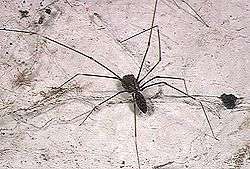Smeringopus
Smeringopus is a genus of cellar spiders that was first described by Eugène Louis Simon in 1890.[2]
| Smeringopus | |
|---|---|
 | |
| Smeringopus pallidus female with egg sac. | |
| Scientific classification | |
| Kingdom: | Animalia |
| Phylum: | Arthropoda |
| Subphylum: | Chelicerata |
| Class: | Arachnida |
| Order: | Araneae |
| Infraorder: | Araneomorphae |
| Family: | Pholcidae |
| Subfamily: | Holocneminae |
| Genus: | Smeringopus Simon, 1890[1] |
| Type species | |
| S. pallidus (Blackwall, 1858) | |
| Species | |
|
55, see text | |
Species
As of June 2019 it contains fifty-five species, found in Africa, South America, Asia, Australia, and on the Pacific Islands:[1]
- S. affinitatus Strand, 1906 – Ethiopia
- S. arambourgi Fage, 1936 – Ethiopia, Somalia
- S. atomarius Simon, 1910 – Namibia, Botswana, South Africa
- S. badplaas Huber, 2012 – South Africa
- S. blyde Huber, 2012 – South Africa
- S. bujongolo Huber, 2012 – Congo, Uganda
- S. butare Huber, 2012 – Congo, Rwanda, Burundi
- S. bwindi Huber, 2012 – Congo, Uganda
- S. carli Lessert, 1915 – Uganda, Tanzania, Comoros, Madagascar
- S. chibububo Huber, 2012 – Mozambique
- S. chogoria Huber, 2012 – Kenya
- S. cylindrogaster (Simon, 1907) – West, Central Africa
- S. dehoop Huber, 2012 – South Africa
- S. dundo Huber, 2012 – Congo, Angola
- S. florisbad Huber, 2012 – South Africa
- S. hanglip Huber, 2012 – South Africa
- S. harare Huber, 2012 – Zimbabwe
- S. hypocrita Simon, 1910 – Namibia, South Africa
- S. isangi Huber, 2012 – Congo
- S. kalomo Huber, 2012 – Zambia, Zimbabwe, Mozambique, Madagascar
- S. katanga Huber, 2012 – Congo
- S. koppies Huber, 2012 – Botswana, South Africa
- S. lesnei Lessert, 1936 – Mozambique, Zimbabwe
- S. lesserti Kraus, 1957 – West, Central Africa
- S. lineiventris Simon, 1890 – Yemen
- S. lotzi Huber, 2012 – South Africa
- S. lubondai Huber, 2012 – Congo
- S. luki Huber, 2012 – Congo
- S. lydenberg Huber, 2012 – South Africa
- S. mayombe Huber, 2012 – Congo
- S. mgahinga Huber, 2012 – Congo, Uganda
- S. mlilwane Huber, 2012 – Swaziland, South Africa
- S. moxico Huber, 2012 – Angola
- S. mpanga Huber, 2012 – Uganda
- S. natalensis Lawrence, 1947 – Mozambique, South Africa. Introduced to Australia
- S. ndumo Huber, 2012 – South Africa
- S. ngangao Huber, 2012 – Kenya, Tanzania
- S. oromia Huber, 2012 – Ethiopia
- S. pallidus (Blackwall, 1858) (type) – Africa. Introduced to the Caribbeen, South America, Sri Lanka, China, Laos, Philippines, Indonesia, Australia, Pacific islands
- S. peregrinoides Kraus, 1957 – Central, East Africa
- S. peregrinus Strand, 1906 – Kenya, Uganda, Tanzania, Madagascar
- S. principe Huber, 2012 – São Tomé and Príncipe
- S. roeweri Kraus, 1957 – Congo, Rwanda, Tanzania, Malawi
- S. rubrotinctus Strand, 1913 – Rwanda, Burundi
- S. ruhiza Huber, 2012 – Uganda, Burundi
- S. sambesicus Kraus, 1957 – Mozambique
- S. saruanle Huber, 2012 – Somalia
- S. sederberg Huber, 2012 – South Africa
- S. similis Kraus, 1957 – Namibia
- S. thomensis Simon, 1907 – São Tomé and Príncipe
- S. tombua Huber, 2012 – Angola
- S. turkana Huber, 2012 – Ethiopia, Kenya
- S. ubicki Huber, 2012 – South Africa
- S. uisib Huber, 2012 – Namibia
- S. zonatus Strand, 1906 – Ethiopia
gollark: I think you should probably be able to? In fact, you shouldn't without someone opting *in*.
gollark: Given your descent into evil.
gollark: I mean, you don't seem to accept anything but a demonstration of how it's better for you if you don't.
gollark: What sort of justification do you *want*?
gollark: Anyway, I would say pailgogoolgoisogsokroasro asor please help I cannot remember that is *pretty* evil.
See also
References
- "Gen. Smeringopus Simon, 1890". World Spider Catalog Version 20.0. Natural History Museum Bern. 2019. doi:10.24436/2. Retrieved 2019-07-05.
- Simon, E. (1890). "Etudes arachnologiques. 22e Mémoire. XXXIV. Etude sur les arachnides de l'Yemen". Annales de la Société Entomologique de France. 10 (6): 77–124.
This article is issued from Wikipedia. The text is licensed under Creative Commons - Attribution - Sharealike. Additional terms may apply for the media files.